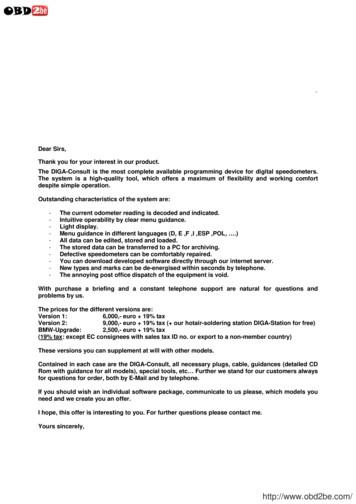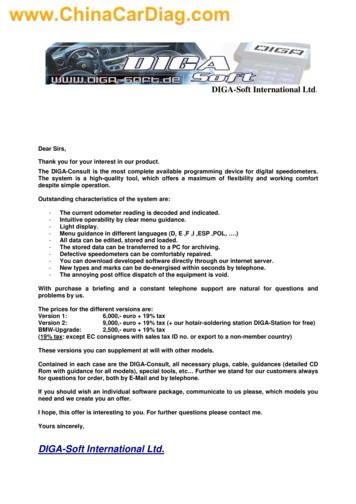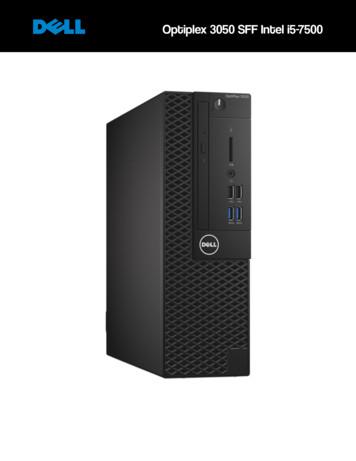Processor Power And Energy Efficiency Consumer Electronic .
WHITE PAPERProcessor power and energy efficiency: White Paper, Title PageProcessor Power and Energy EfficiencyConsumer electronic microprocessorimprovements provide catalyst for industrialautomation advancements.By Jason Horine,Product Engineer, Programmable Logic Controllers, AutomationDirectThe #1 Value in Automation.
Processor power and energy efficiency: White Paper, pg. 2WHITE PAPERThink about what your cell phone was like 15 years ago. Most likely, it could be usedonly for telephone calls—no texting, no photos, no videos and no music. Think aboutyour business trips then with your carry-on bag crammed with a camera, a portable CDplayer, a travel alarm, maybe a GPS, possibly a tape recorder, a day planner, a calculatorand more.Now fast forward to today—where a smart phone can be used to perform all ofthese functions—and many more including fast Internet access, golf course distancecalculations and many other tasks via imaginative apps.The same trend of combining what once required separate components into onedevice is also apparent in industrial automation. Interestingly, the impetus for modernmobile phones to perform many functions with less energy consumption has helpedmake industrial automation components more powerful, less expensive andmore reliable.An Unlikely ConnectionThe goal of increasing energy efficiency while augmenting processor power is drivenby the consumer electronics market, especially in regards to mobile devices such as cellphones. However, industrial automation equipment isn’t portable, so there’s typicallyno battery life to consider.While energy efficiency is vital for consumer electronics, this isn’t necessarily the casein the automation world where the power consumed by the control panel is usuallyinsignificant compared to that of the process being controlled. Moreover, althoughenergy costs are soaring, amortized hardware costs still dwarf energy costs in terms ofprocessors and other automation hardware.It may therefore seem that the relationship between energy efficiency and processorpower has no effect on the industrial automation world. However, the industrialautomation customer does benefit from the chip manufacturers’ perpetual goal tocreate processors that do more while using less energy, a goal that requires cramminga great deal of functionality onto ever fewer chips.Industrial automation users may not worry about the processor energy requirements,but these new powerful chips offer many advantages to the automation world in termsof price, time-to-market, flexibility and reliability.More Functionality, Lower CostsThe research and development cycle for new microprocessors used in mobileconsumer electronic devices is pushing down the price of processors to the level whereautomation suppliers can now offer very advanced, multi-function products atlow cost.Save on processing power from AutomationDirect:www.AutomationDirect.com/plcsThe #1 Value in Automation.
Processor power and energy efficiency: White Paper, pg. 3WHITE PAPERDemands for increased energy efficiency for mobile phones have prompted chipmakers to integrate functions such as memory, Wi-Fi, USB and memory card interfacesonto a single chip. Performing numerous and heretofore disparate functions within asingle chip is one of the biggest benefits to come from new component designs.In the industrial automation world, this means that functionality that used to requirea printed circuit board (PCB) with 60 or more chips can now be provided with a singlechip. This has enabled design engineers to create new applications in compact formfactors that previously would have been impractical because of the PCB area requiredto house, power and connect all the chips and related components.We see this trend in PLCs where the integration of more components intomicroprocessors has eliminated the need for additional external automationcomponents. These components include but aren’t limited to data loggers, ASCII ormath co-processors, digital communication cards, proportional–integral–derivative(PID) controllers and more.Remember when you had to buy a separate Ethernet module, and all the hassleinvolved with integrating the module with the CPU module? Today, all but the very leastexpensive PLCs include an Ethernet port, with many featuring multiple Ethernet andother communication ports.Many of us recall the time when a data logger was an individual entity, with its ownmounting rack, power supply, CPU, I/O and memory. High-end PLCs that included datalogging were introduced to eliminate the need for separate data logging systems inmost applications, and now even inexpensive PLCs often have this feature. In additionto data logging, many PLCs offer database connectivity through the aforementionedcommunication ports, often supporting a wide variety of networking protocols.Better ReliabilityConsolidating functionality into ever fewer components, primarily the CPU for the PLC,doesn’t just provide more room in the control cabinet. It also creates lower overall costsand power usage for the total system, as well as easier integration and greater reliability.In part, designs with higher integration of functions built into the processor are morereliable. This is because less of the working circuit is exposed to external influence,like electromagnetic interference (EMI), generated by other devices in the area. Theyalso naturally produce less EMI of their own. They’re also less susceptible to surfacecontaminants, since so many of the connections are sealed within the die of the chip.The same logic applies to the control cabinets themselves. For example, many formerperipheral modules are now incorporated into single products like PLCs. This increasesreliability by reducing external connections, while removing the need to integratedisparate components into a working whole. A modern system typically uses fewerpower supplies and generates far less heat in the cabinet, further improving long-termreliability and reducing cooling costs.Save on processing power from AutomationDirect:www.AutomationDirect.com/plcsThe #1 Value in Automation.
Processor power and energy efficiency: White Paper, pg. 4Highly CustomizableWHITE PAPERThe semiconductor industry is releasing new tools all the time that help designengineers satisfy their customers’ needs for smaller footprints, increased reliability,easier programming, faster implementation and more.How does this translate to the automation world? Many PLC and industrial PCdevelopers are incorporating dual core ARM Cortex-A processor technology, originallydesigned for smart phones, into their designs. The ARM microprocessor has gainedpopularity because of its features, peripheral functions, low power draw and flexibility.Field-programmable gate arrays (FPGAs) have significantly benefited from highperformance, low energy chip technology developed for the consumer electronicmarket. “These FPGAs can be installed within a PLC or industrial PC controller andperform tasks such as very high speed control and synchronization, which used torequire separate automation components,” explains Robert Oglesby, president of HostEngineering (www.hosteng.com). “By pairing one or more FPGAs with off-the-shelfparts, such as the ARM chip, developers can create highly customizable products at amuch lower cost.”Benefits of borrowing fromconsumer electronics Very powerful chips at low cost Decreased overall power consumption because a single processorcan eliminate several pieces of hardware High level of design flexibility Many functions of the product are programmed into the CPU orFPGA, not built-up in hardware Fewer changes to the PCB occur since more engineering changeshappen in the code, instead of in the hardware Risk of component obsolescence is reduced More post-launch feature upgrades are possible with just afirmware changeTable 1: Industrial automation benefits derived from consumer electronics technology.Easily Programmable, More Flexible DesignFPGA chips are not only extremely versatile, they now also come with tools thatspeed up development and enable changes to be made on the fly. Because FPGAs arereprogrammable, it’s easy to change hard-wired logic without having to buy new ASICsand design new printed circuit boards.Save on processing power from AutomationDirect:www.AutomationDirect.com/plcsThe #1 Value in Automation.
Processor power and energy efficiency: White Paper, pg. 5WHITE PAPERDavid White, senior design engineer with FACTS Engineering (www.facts-eng.com),describes how his company has been able to create a lower cost, higher performancemotion control module using an FPGA-based Digital Signal Controller (DSC).“The DSC was developed to provide better audio for consumer electronics. While theautomation world doesn’t use the DSC for improving audio, it does benefit from itscapabilities in motor control, power conversion and sensor processing applications,”says White.Modern DSCs are highly flexible and very powerful. They can be used to control powersupplies, inverters and stepper motors where they provide substantial energy and costsavings while increasing reliability and reducing circuit footprints.“Because there is so much functionality integrated into the DSC, we’ve been ableto create a motion control module at a much lower cost,” adds White. “The DSChandles what once required numerous chips, and modern development tools makeconfiguration easy because it’s done in the software development environment insteadof hard-wired,” explains White.Caveats for the Industrial Automation WorldMany industrial automation users are less comfortable with unfamiliar technologiesand applications made available from these advancements. The challenge is to provideusers with a familiar look and feel, while offering more powerful features for users whoneed advanced capabilities.“You need to know how to satisfy the needs of both types of users by respecting thelegacy while embracing the new,” says Robert Oglesby, president of Host Engineering.“You want it to give customers something they’re comfortable with, while alsoproviding the maximum price-performance ratio with high reliability.”Save on processing power from AutomationDirect:www.AutomationDirect.com/plcsThe #1 Value in Automation.
Processor power and energy efficiency: White Paper, pg. 6WHITE PAPERSidebar: Analog module technology comparisonSometimes a picture really isworth a thousand words. Asshown here, two modules, oneapproximately 10 years old andthe other new, depict a hugechange in design as a result ofthe advances in technologydriven by the consumerelectronics market.Old Technology (F4-08AD)For an accurate evaluation, the two modules shown are a direct apples-to-applescomparison with regard to form, fit, and function. They both supply eight channelsof analog inputs to their corresponding PLC system. In the older analog module thecomponents are mostly through-hole, which means they have two or more leadswhich protrude through the circuit board and are soldered on the back side. The newermodule shown below is composed almost exclusively of surface mount components,which means they are soldered directly to the surface of the circuit board.F4-08AD (old technology) vs. P3-08AD (new technology)0-20mA 0-5VDC4-20mA 0-10VDC /-5VDC 12-Bit16-Bit /-10VDC Resolution ResolutionF4-08AD ( 495) P3-08AD ( 332) SoftwareBuilt-InConfigurable LCD An important benefitgained from applying thelatest consumer electronictechnologies is the reducedfootprint of the componentsrequired to design the modulecircuitry. The new modulegreatly reduces the number ofcomponents and chips, so aNew technology (P3-08AD)single smaller circuit board cannow offer the same functionalitythat formerly required almost two full-sized circuit boards.Another benefit is the reduced cost that goes along with smaller size and greaterperformance. The chart shows the two modules’ offerings along with the correspondingprice. Not only does the price drop, but the new module contains extra functionalitiesthat increase the price/performance ratio. The inclusion of configurable software in thenew module enables developers to configure the module much easier and faster thanin the past. The built-in LCD in the new module provides greater diagnostic capabilities,including display of the raw values in counts, voltage, mA, and more.Save on processing power from AutomationDirect:www.AutomationDirect.com/plcsThe #1 Value in Automation.
Processor power and energy efficiency: White Paper, pg. 8WHITE PAPERAbout AutomationDirectIn business since 1994, AutomationDirect is a distributor offering thousands ofindustrial automation products for electrical control systems, including PLCs, operatorinterfaces, AC drives, motors, stepper systems, sensors, motor control, enclosures andmore. Their prices are typically well below the list price of more traditional automationcompanies because of their model and focus on efficiency and the majority of theirproducts are stocked for same-day shipping. Plus, get free two-day delivery on ordersover 49; some limitations apply. For more information, contact them at 800-633-0405or visit www.AutomationDirect.com/plcsSave on processing power from AutomationDirect:www.AutomationDirect.com/plcsThe #1 Value in Automation.
Processor power and energy efficiency: White Paper, pg. 3. WHITE PAPER. Demands for increased energy efficiency for mobile phones have prompted chip . makers to integrate functions such as memory, Wi-Fi, USB and memory card interfaces onto a single chip. Perfor
Alfa Romeo 145 old Processor new Processor 2004 146 old Processor By new Processor DIGA-Soft.de 147 Eeprom 147 NEC-Processor 156 before 2002 Cluster-Plug since 2002 Cluster-Plug 159 Eeprom 166 Processor Model 2002 Eeprom Spider Processor GT Eeprom GTV Processor All JTD (Diesel)
- The annoying post office dispatch of the equipment is void. . Alfa Romeo 145 old Processor new Processor . 147 NEC-Processor 156 before 2002 Cluster-Plug since 2002 Cluster-Plug 159 Eeprom 166 Processor Model 2002 Eeprom Spider Processor GT Eeprom GTV Processor All JTD (Diesel) Motor-Control Unit .
3050 SFF Intel i 5-7 00. Puertos y ranuras: factor de forma pequeño 1. Botón de encendido 2. . Small Form Factor Height: 289.6 mm Weight (Approximate): 5.14 kg Width: 94 mm Processor & Chipset Processor Generation: 7th Gen Processor Manufacturer: Intel Processor Model: i5-7500 . Processor Speed: 3.40 GHz Processor Type: Core i5 Software .
processor appears as a single processor running a single C program. This is very different from some other parallel processing models where the programmer has to explicitly program multiple independent processor cores, or can only access the processor via function calls or some other indirect mechanism. The processor executes a single instruction
ThinkPad X1 Titanium Yoga Gen 1 PSREF Product Specifications Reference ThinkPad X1 Titanium Yoga Gen 1 - December 08 2022 1 of 8. PERFORMANCE Processor Processor Family 11th Generation Intel Core i5 / i7 Processor Processor** Processor Name Cores Threads Base Frequency Max Frequency Cache Memory Support Processor Graphics
policy with the ECOWAS renewable energy (EREP) and ECOWAS energy efficiency policies (EEEP). It therefore mandates the implementation of the national renewable energy action plan (NREAP) and a national energy efficiency action plan (NEEAP), at the completion of which a revised renewable energy and energy efficiency policy will update this one.
4.2.5 Energy efficiency can increase the energy access. 4.2.6 Energy efficiency can help increase energy security by reducing energy import and energy deficiency. 4.2.7 Energy efficiency can help in achieving the goals of sustainable development, in reducing carbon emission and environmental imbalance and in minimizing the negative effects of
ASME BPV CODE, EDITION 2019 Construction Code requirements Section VIII, Div. 1, 2 a 3 ; Section IX ASME BPV Section V, Article 1, T-120(f) ASME BPV Section V, Article 1, Mandatory Appendix III ASME BPV Section V, Article 1, Mandatory Appendix II (for UT-PA, UT-TOFD, RT-DR, RT-CR only ) SNT-TC-1A:2016; ASNT CP-189:2016 ASME B31.1* Section I Section XII ASME BPV Section V, Article 1, Mandatory .























